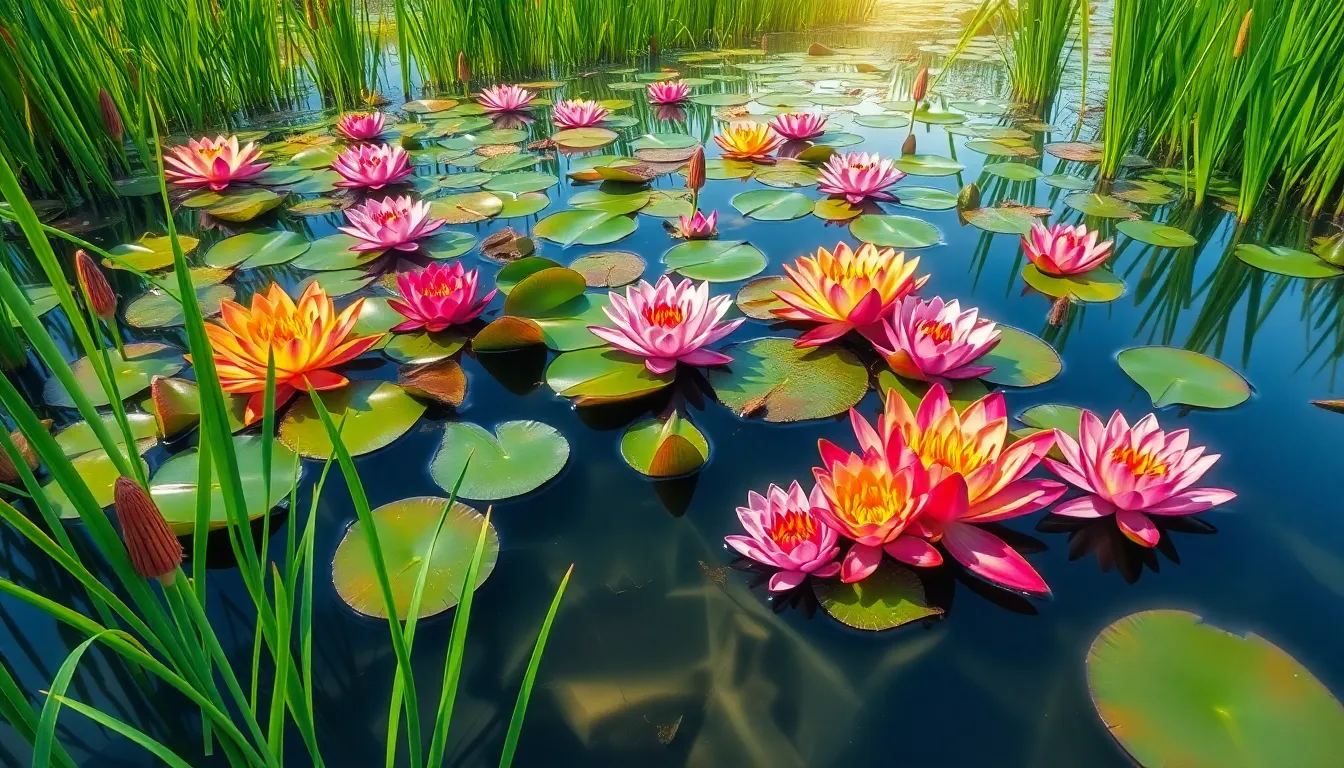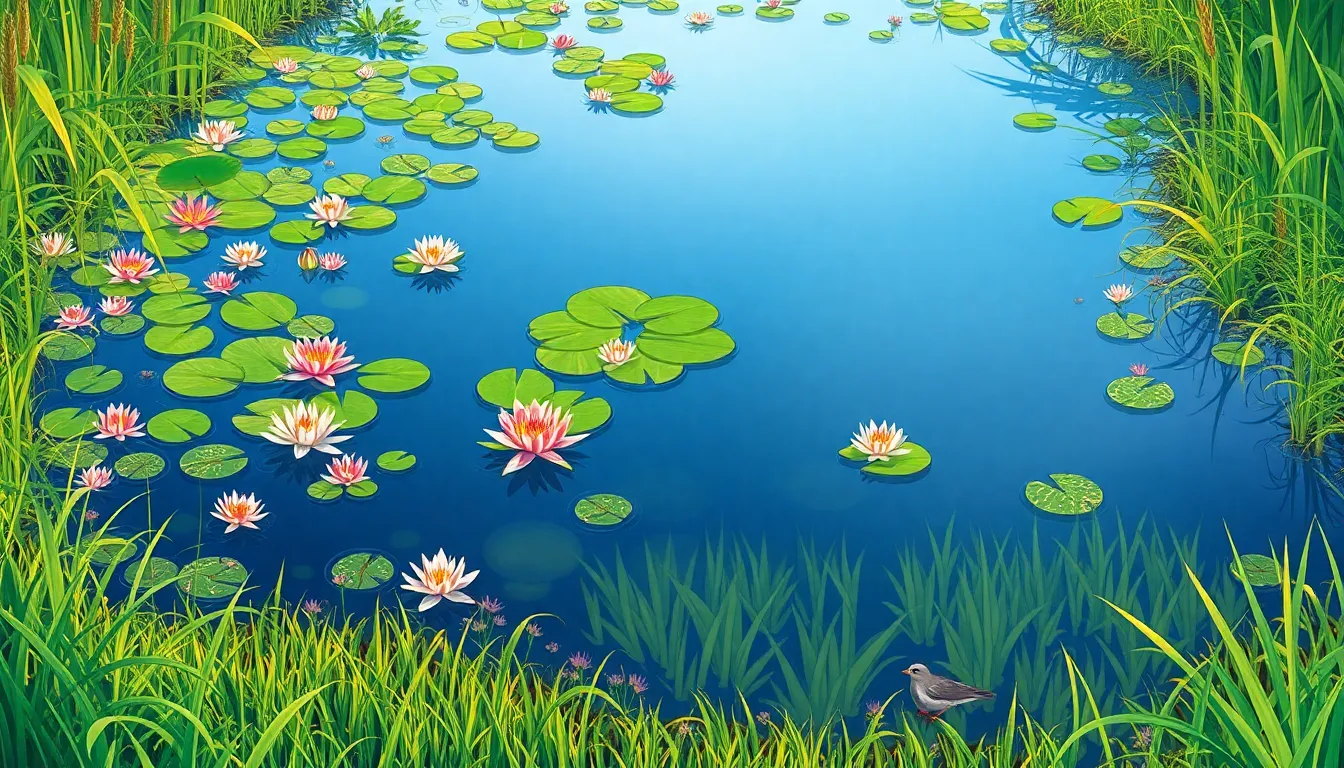Transforming a bland backyard into a serene oasis might seem like a daunting task, but aquatic pond plants are here to save the day. These green wonders not only beautify your pond but also create a thriving ecosystem that even the pickiest frogs would be proud to call home. Who knew that adding a splash of greenery could turn your water feature into a vibrant paradise?
Aquatic Pond Plants
Aquatic pond plants fall into three main categories, each serving unique roles in creating a balanced ecosystem. These categories include submergent, emergent, and floating plants.
Submergent Plants
Submergent plants thrive underwater and provide essential habitats for aquatic creatures. Examples include eelgrass, which supports fish populations, and hornwort, known for its oxygenation capabilities. These plants filter water, enhancing clarity while providing shelter for fish and invertebrates. Both species contribute to the overall health of the pond.
Emergent Plants
Emergent plants grow partially above water and play a crucial role in stabilizing shorelines. Notable examples are cattails and bulrushes, which help prevent erosion. They also offer nesting sites for birds and breeding grounds for amphibians. This category significantly enhances biodiversity while providing necessary shade and atmospheric cooling to the water.
Floating Plants
Floating plants rest on the water’s surface and provide shade while reducing algae growth. Water lilies and duckweed belong to this category, both offering aesthetic beauty and practical benefits. These plants absorb excess nutrients, preventing overgrowth and ensuring a balanced ecosystem. Their leaves create habitats for insects and provide shelter for fish.
Benefits Of Aquatic Pond Plants

Aquatic pond plants offer numerous advantages that enhance both the environment and visual appeal of water features.
Ecological Advantages
Aquatic pond plants play a crucial role in maintaining a balanced ecosystem. They improve water quality by absorbing excess nutrients, which reduces algae growth. Submergent species, such as eelgrass, provide habitats for fish and other aquatic organisms. Emergent plants like cattails stabilize shorelines, preventing erosion from wave action. Floating plants, including water lilies, offer shade that cools water, benefiting fish and other aquatic life. Birds, frogs, and beneficial insects thrive in habitats created by these plants, promoting biodiversity. Together, these factors create a harmonious environment where wildlife can flourish.
Aesthetic Appeal
Aquatic pond plants significantly enhance the visual beauty of water features. Colorful flowers from floating plants like water lilies create striking focal points. The lush foliage of emergent plants, such as bulrushes, adds texture and depth to pond edges. Submergent plants improve water clarity, making the pond look more inviting. Varied heights and shapes of different plant types introduce dynamic landscapes that captivate observers. The overall effect transforms a simple pond into a vibrant oasis, attracting visitors and elevating outdoor spaces.
How To Choose Aquatic Pond Plants
Selecting the right aquatic pond plants enhances both aesthetics and ecology in water features. Various factors influence plant choice, ensuring compatibility with the pond environment.
Considerations For Your Pond Environment
Assessing the pond’s conditions plays a vital role in plant selection. Water depth affects which plants thrive; deeper ponds may suit submergent varieties, while shallower areas benefit from emergent species. Sunlight availability influences growth; if a pond receives full sun, consider sun-loving plants like water lilies. Additionally, local climate impacts plant longevity; cold climates require varieties that can endure frost. The pond’s overall ecosystem, including existing wildlife and water quality, also determines suitable plant types.
Plant Size And Growth Rate
Understanding the growth habits of aquatic plants is essential for a harmonious pond. Some species, like water hyacinth, spread rapidly, while others, such as water lilies, grow at a more moderate pace. Larger varieties need ample space to flourish; avoiding overcrowded pond conditions supports health and beauty. Consider future maintenance; faster-growing plants may require regular trimming. Balancing plant size and growth rate ensures visual appeal while maintaining a healthy ecosystem in the pond.
Maintenance Of Aquatic Pond Plants
Maintaining aquatic pond plants is essential for a thriving ecosystem. Regular care ensures their health and enhances the pond’s aesthetic appeal.
Seasonal Care Tips
Springtime marks a crucial period for aquatic plants. Regularly check the water temperature and clarity as the weather warms. Trimming dead foliage boosts growth. In summer, monitor nutrient levels; algae can flourish if excess nutrients accumulate. Providing adequate shade helps prevent overheating. Come autumn, shearing back overgrown plants prepares them for dormancy. Finally, winter entails careful monitoring; protecting sensitive species from freezing temperatures preserves plant health.

Common Pests And Diseases
Pests like aphids and snails can threaten aquatic plants. Inspect leaves regularly for signs of damage or infestation. Minor infestations can often be controlled using natural predators or introducing biological controls. Fungal diseases might also occur, particularly in damp conditions. Signs include discoloration or wilting leaves. Applying appropriate fungicides helps combat these issues. Maintaining good water quality reduces the risks associated with many pests and diseases, ensuring a healthy pond environment.
